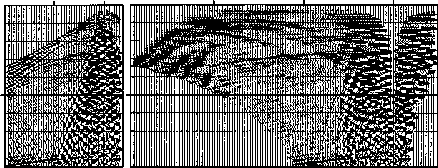Moveout correction may be regarded as a transformation
from time to depth.
When the moveout correction is properly done,
all traces should show the same depth-dependent reflectivity.
In principle, radial moveout correction proceeds by
introducing z and
eliminating t with the substitution ![]() .In practice you would prefer a travel-time-depth axis to a depth axis.
So the transformation equation
becomes
.In practice you would prefer a travel-time-depth axis to a depth axis.
So the transformation equation
becomes ![]() .Eliminating x with rt we get
.Eliminating x with rt we get
| |
(4) |
Inspecting (4) we see that moveout correction
in radial-trace coordinates is a
uniform
compression
of the time t-axis into a ![]() -axis.
The amount of compression is fixed when r is fixed.
The amount of compression does not change with time.
The uniformity of the compression is an aid to modeling
and removing the effects of shot waveforms and multiple reflections.
It is curious to note that
moveout correction of radial traces
compresses
time, while
moveout correction of constant-offset data
stretches
time nonuniformly.
Figure 4 shows a field profile before and after
the radial-trace transformation.
-axis.
The amount of compression is fixed when r is fixed.
The amount of compression does not change with time.
The uniformity of the compression is an aid to modeling
and removing the effects of shot waveforms and multiple reflections.
It is curious to note that
moveout correction of radial traces
compresses
time, while
moveout correction of constant-offset data
stretches
time nonuniformly.
Figure 4 shows a field profile before and after
the radial-trace transformation.
 |